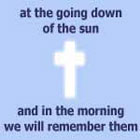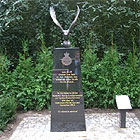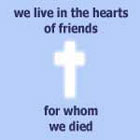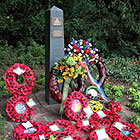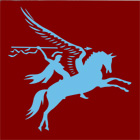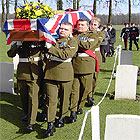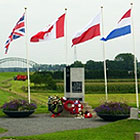Name: Donald Parker
Rank: Staff Sergeant
Unit: 'D' Squadron
Regiment: The Glider Pilot Regiment
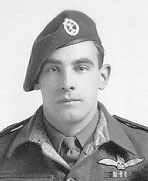 I was aged 24 and had previously landed a
Horsa Glider in Normandy on D-Day. We had moved to another drome called "Blake- hill
farmand" and had been there since august. We had early in september been briefed for
the operation with just the 1 st Airborne division doing the whole operation. I was to
land beside the bridge at Grave. However, this was canceled. I was detailed to fly to
Arnhem on the second lift on September 17th. I was flying co-pilot to our flight
commander, Captain Morrison. We were up early around five o'clock on the morning of the
18th. Our glider was loaded with a jeep and a seven pounder gun plus 5 gunners and gun
ammunition. However there was thick mist on the drome and we did not get taking off until
12 o'clock when the mist cleared. The aircraft that was towing us was a Dakota. After we
had got into formation we were bound for Holland, our operation height was 2000 feet. We
had one moment of anxiety over the north sea when our tug was switching to his long range
tank and his engine stalled. We lost considerable height but his engines restarted. We
passed over the coast of Holland which I remember was all flooded with just the roof of
the houses showing above the water.
I was aged 24 and had previously landed a
Horsa Glider in Normandy on D-Day. We had moved to another drome called "Blake- hill
farmand" and had been there since august. We had early in september been briefed for
the operation with just the 1 st Airborne division doing the whole operation. I was to
land beside the bridge at Grave. However, this was canceled. I was detailed to fly to
Arnhem on the second lift on September 17th. I was flying co-pilot to our flight
commander, Captain Morrison. We were up early around five o'clock on the morning of the
18th. Our glider was loaded with a jeep and a seven pounder gun plus 5 gunners and gun
ammunition. However there was thick mist on the drome and we did not get taking off until
12 o'clock when the mist cleared. The aircraft that was towing us was a Dakota. After we
had got into formation we were bound for Holland, our operation height was 2000 feet. We
had one moment of anxiety over the north sea when our tug was switching to his long range
tank and his engine stalled. We lost considerable height but his engines restarted. We
passed over the coast of Holland which I remember was all flooded with just the roof of
the houses showing above the water.
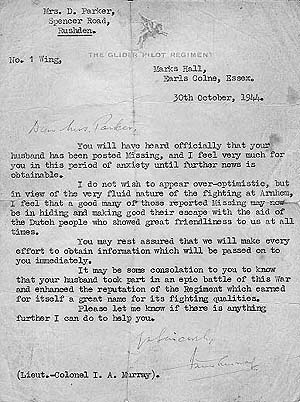 There was some tracer fire direct at us but our fighter escorts dived to
attack this barge with a gun on it in a farmyard. The canon shell of the fighters made
very spectacular splashes in the water. We passed I believe over 's Hertogenbosch and
after a while we could see the Arnhem bridge. Our tug pilot towed us into position and
told us to release and wished us good luck. As there was a lot of firing at us, everybody
had maximum flap on for a steep gliding angle. We had two near misses of collisions but
landed succesfull on landing zone S. I did not go back to where we landed for fourty years
but I found the spot straight away as I never forgot the rattle of the jeep and gun going
over the level crossing at Wolfheze station. We then made our way into Oosterbeek and the
gun was set up at the crossroads and bridge near the railway station. We then moved to a
crossroad at the Arnhem side of I think it is Utrechtseweg. During the next two days we
had come back house by house to the corner at the Schoonoord Hotel , all of wich was first
aid posts. One of the things I remember very vividly was, we had retreated to a house
further down the street, the windows were all barricated up. There were two or three
candles still burning and on the table was a dead paratrooper, on the floor several more.
It was evident that the surgeon was operating two or three minutes before we entered. It
was a most poignant site. Shortly after this we were in the Hartenstein. The mortar fire
was incessent, with them landing beside the trench a good friend was killed virtually
beside me. He looked so very peacefull and must have been concussion from the shell. There
was a lull the next morning and we got out of the trench and made us some breakfast.I
heard this shell coming and dived into the trench. Unfortunatly the two who were with me
were killed as the shell hit the tree and exploaded. When I went back some years ago, I
found the tree with the scar still on its trunk.
There was some tracer fire direct at us but our fighter escorts dived to
attack this barge with a gun on it in a farmyard. The canon shell of the fighters made
very spectacular splashes in the water. We passed I believe over 's Hertogenbosch and
after a while we could see the Arnhem bridge. Our tug pilot towed us into position and
told us to release and wished us good luck. As there was a lot of firing at us, everybody
had maximum flap on for a steep gliding angle. We had two near misses of collisions but
landed succesfull on landing zone S. I did not go back to where we landed for fourty years
but I found the spot straight away as I never forgot the rattle of the jeep and gun going
over the level crossing at Wolfheze station. We then made our way into Oosterbeek and the
gun was set up at the crossroads and bridge near the railway station. We then moved to a
crossroad at the Arnhem side of I think it is Utrechtseweg. During the next two days we
had come back house by house to the corner at the Schoonoord Hotel , all of wich was first
aid posts. One of the things I remember very vividly was, we had retreated to a house
further down the street, the windows were all barricated up. There were two or three
candles still burning and on the table was a dead paratrooper, on the floor several more.
It was evident that the surgeon was operating two or three minutes before we entered. It
was a most poignant site. Shortly after this we were in the Hartenstein. The mortar fire
was incessent, with them landing beside the trench a good friend was killed virtually
beside me. He looked so very peacefull and must have been concussion from the shell. There
was a lull the next morning and we got out of the trench and made us some breakfast.I
heard this shell coming and dived into the trench. Unfortunatly the two who were with me
were killed as the shell hit the tree and exploaded. When I went back some years ago, I
found the tree with the scar still on its trunk.
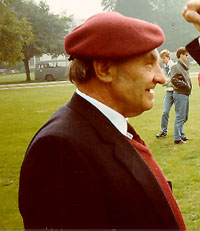 Its hard to think when you walk around the Hartenstein, how different a place
it was all those years ago. On the Saturday of that week, in the early evening, we were
ordered to make our way down to the river. The jeep, wich we still had, had been hit with
mortar shells several times. We had to keep stopping to put water in the radiator. Also,
the jeep would only turn to the right. Each time we wanted to go left, we had to stop, get
out, and lift it round to the left. About two hundred yards from the Hartenstein,
unfortunatly for the two of us remaining, we turned to the right and straight into a
German position. We were immediatly surrounded and I was taken prisoner. I was wounded
twice but only superficially.
Its hard to think when you walk around the Hartenstein, how different a place
it was all those years ago. On the Saturday of that week, in the early evening, we were
ordered to make our way down to the river. The jeep, wich we still had, had been hit with
mortar shells several times. We had to keep stopping to put water in the radiator. Also,
the jeep would only turn to the right. Each time we wanted to go left, we had to stop, get
out, and lift it round to the left. About two hundred yards from the Hartenstein,
unfortunatly for the two of us remaining, we turned to the right and straight into a
German position. We were immediatly surrounded and I was taken prisoner. I was wounded
twice but only superficially.
I finished up in "Stalag Luft 7" in Ober Silesia and was on that dreaded winter march from there to Berlin. One thing that stands out when you visit Oosterbeek Cemetery is how young we all were....some graves read 18, 19, 20. I was old at 24. I do not know whether I will be visiting Arnhem as I am 76 years old now. Trusting that you will be able to read this letter, and please forgive my terrible writing and the brevity as it would take a book to write all about those ways of life at that time.
Editor: Staff Sergeant D. Parker currently lives in The Republic Of Ireland.



